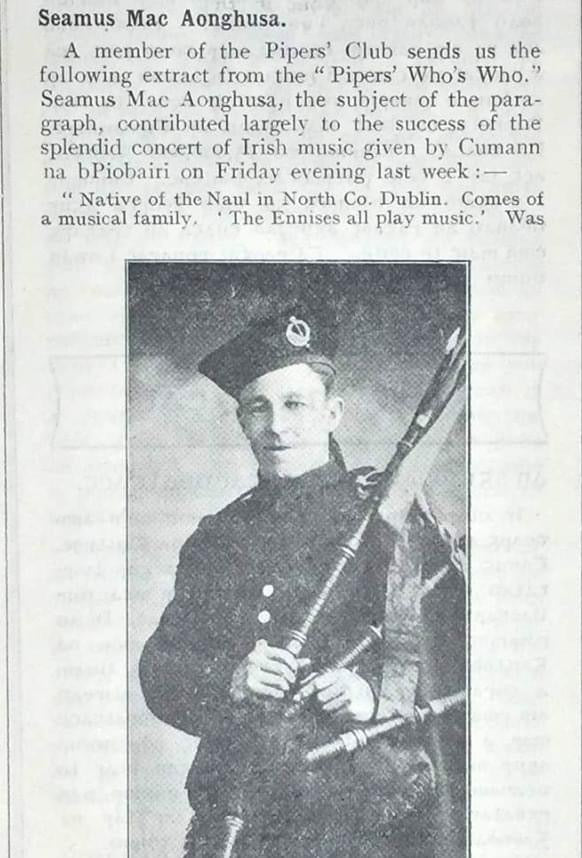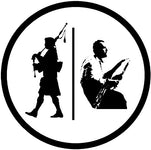
Séamus Ennis: The War Piper Behind the Legend
When most folks think of Séamus Ennis, it’s his masterful touch on the uilleann pipes that springs to mind. And rightly so – he was a giant in Irish traditional music, a collector of tunes who roamed the country on his bike, soaking up songs and stories from every corner. But there’s another side to Séamus that’s often overlooked: his prowess as an Irish war piper. In a family steeped in music, the war pipes – those bold, mouth-blown beasts akin to their Scottish cousins – were as much a part of his story as the gentler uilleann sets. Today, let’s shine a light on that lesser-known chapter, drawing from old clippings and family tales that paint a picture of a young man who carried the spirit of the pipes into battlefields of competition and beyond.

Born in 1919 in Jamestown, north County Dublin, Séamus grew up in a household where music wasn’t just a hobby – it was the air they breathed. His father, James Ennis, a civil servant from the Naul, was the real spark. James wasn’t content with dabbling; he was a champion Irish dancer and a multi-instrumentalist who could coax magic from the flute, the fiddle, and both kinds of pipes. He led the Dublin Warpipers’ Band to victory at the 1910 Oireachtas band competition, and snagged first prize for solo war piping in 1912, along with the Bigger prize for the best all-round war piper. James even founded the Naul Pipe Band, turning their quiet village into a hub for piping enthusiasts. It’s no wonder Séamus later said, “I’m told that my father used to play the pipes to me in my cradle and that I wouldn’t go to sleep until the pipes were played to me.” From the cradle onwards, the war pipes’ drone was his lullaby.
Séamus’s grandfather was a musician too, and the family roots in the Naul ran deep – generations of Ennises called it home. There’s a charming story Séamus told about his great-grandfather eloping from Scotland to set up a farm there, adding a dash of Highland flair to their Irish heritage. But it was James who passed the torch directly. Under his guidance, Séamus and his siblings dove headfirst into the world of music. By his teens, Séamus was already a prodigy, handling the flute like a natural, whistling tunes on all sorts of piccolos and flutes, and even fiddling with equal ease. The war pipes, though? They were a family staple, and Séamus took to them with the same fire his father had.
One old newspaper clipping from the Pipers’ Club captures this beautifully. It describes Séamus Mac Aonghusa (as he’s named there, in the Irish form) contributing to a splendid Irish music concert by Cumann na bPíobairí in Dublin. “Native of the Naul in North Co. Dublin. Comes of a musical family. ‘The Ennises all play music.’” The piece highlights his war piping roots, noting how he, his brother, and Eamonn Ceannt were among the first war pipers of the “new dispensation” to visit London – decked out in full war paint, no less. This was back in the day, many years before the article, likely in the turbulent times around the wars. Imagine the scene: young Irish pipers crossing the sea, pipes in hand, bringing a bit of home to the streets of London amid the chaos. It’s a reminder that war pipes weren’t just for parades; they carried a weight of history, echoing the battle cries of old while adapting to new eras.
That same clipping paints Séamus as a true all-rounder. He wasn’t just piping – he was a prize-winner in flute-playing, fiddling, war-piping, and union-piping. The only instruments that stumped him were the melodeon and piano! He played at big league concerts, like one at Queen’s Hall, and even dabbled in champion dancing. There was a sketch of him that caused a stir, a weekly caricature by way of a drawing in The Sketch magazine. And get this: he once ran a whole concert by himself in Bristol. On top of that, Séamus was a sportsman through and through – a champion footballer for Keatings, a hurler for his native Naul team until they disbanded, and a cyclist who pedaled 19 miles daily from the Naul to his office at the G.P.O. Even after a health scare, he bounced back, spending holidays in Rosmuck as a fine Irish speaker. Still in his early twenties at the time of that article, Séamus was already eyeing a future where he could teach the next generation of pipers.

Of course, Séamus’s legacy grew far beyond those early war piping days. He became a folklore collector for the Irish Folklore Commission, traveling Ireland to preserve tunes that might otherwise have faded away. Later, he worked for Radio Éireann and the BBC, sharing his knowledge with the world. But it’s worth remembering that the war pipes were there from the start, shaping his ear and his style. In a way, they bridged the gap between the martial traditions of old Ireland and the intimate sessions where uilleann pipes shine.
If you’re delving into Irish piping, whether uilleann or war, Séamus Ennis’s story is a treasure trove. Take a look at this vintage photo of him in uniform, pipe in hand – it’s a snapshot of a man who embodied the pipes’ power. Or this extract from the “Pipers’ Who’s Who,” detailing his multifaceted talents. They remind us that behind every legend is a foundation built on family, practice, and a bit of bold adventure.
What do you think – ever tried your hand at the war pipes? Drop a comment below if Séamus’s tale inspires you to pick up the chanter. Sláinte to the Ennises, and to the music that keeps marching on.

Leave a comment